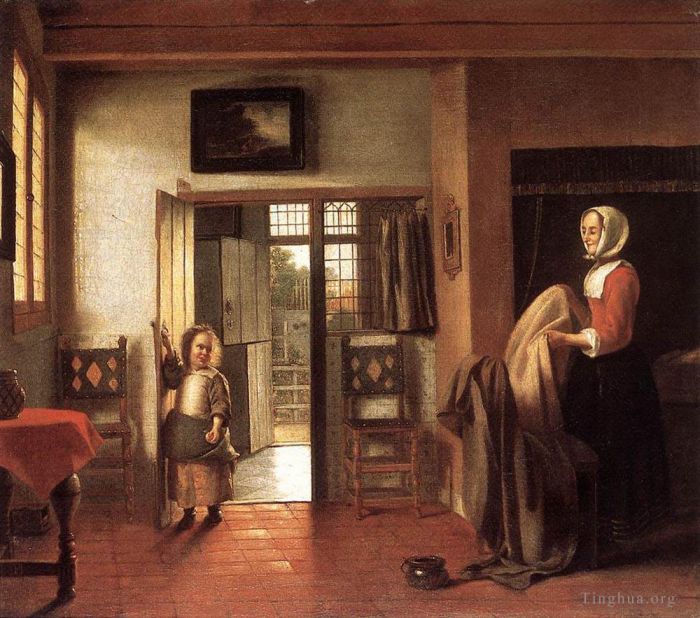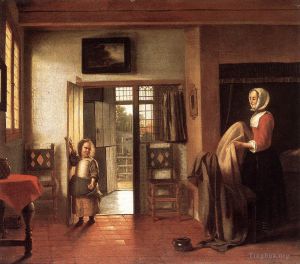The Bedroom
Pieter de Hooch
- Price:
- Art Type: Oil Painting
- Size:
- English Comments: 0
- International Comments: 0
- Creating Date:
- Introduction and Works of Pieter de Hooch >>
Keywords:
Bedroom
Work Overview
- The Bedroom
Artist Pieter de Hooch
Year 1658-1660
Dimensions 51 cm × 60 cm (20 in × 24 in)
Location National Gallery of Art, Washington, D.C.
Pieter de Hooch excelled in the sensitive depiction of people going about their daily lives, be it inside their houses or in the sheltered environment of an urban courtyard. His masterly control of light, color, and complex perspectival construction can be compared to the work of Johannes Vermeer, his contemporary and colleague in Delft.
Through his careful arrangement of the interior space in The Bedroom and his treatment of light, De Hooch infused this everyday scene with an extraordinary intimacy and warmth. Two light sources—the double windows on the left plus the open Dutch door and transom at the front of the house—illuminate the child who opens the door to the inner room. The doorway is flanked by rows of glazed Dutch tiles depicting popular children’s games. Based on the dress, the youngster could be either a girl or a boy. All small children wore skirts, regardless of gender, and the age at which a boy would change to wearing breeches was rather fluid. It is possible that De Hooch depicted his own family: his wife, Jannetje, and either his son, Peter, born in 1655, or his daughter, Anna, born in 1656.
The painting’s traditional title of The Bedroom is somewhat misleading, for the box bed against the wall was part of a large multifunctional room. The mother, busy tending to the chamber pot and airing out the linens, prepares the room for its daytime uses. The harmonious character of De Hooch’s painting and its emphasis on the mother’s dual responsibility as nurturer of her child and caretaker of the home, embody the ideal of Dutch domestic felicity.
The Bedroom (1658–1660) is an oil on canvas painting by the Dutch painter Pieter de Hooch, it is an example of Dutch Golden Age painting and is part of the collection of the National Gallery of Art.
This painting by Hooch was documented by Hofstede de Groot in 1910, who wrote; "78. THE BEDROOM. Sm. 29, 55. This picture is similar in all respects to the picture at Karlsruhe (72), except that the little mirror hanging at the side of the bed has no ornament at the top and bottom. It has every sign of authenticity. Canvas, 20 inches by 23 inches. Mentioned by Waagen, ii. 71.
Sales:
S. J. Stinstra, in Amsterdam, May 22, 1822, No. 86 (25 florins, De Vries).
Lord Radstock, at Christie's, in London, 1826 (70 guineas) ; 1827 (bought in at 150).
Said by Smith (in 1833) and by Waagen to be in the collection of Lord Stafford, but not mentioned in the book on this collection which is still at Bridgewater House.
Sales. Amsterdam, April 24, 1838 (3311 florins, Brondgeest).
E. P. Cremer, in Middelburg, May 17, 1847, No. 8. Field, London, 1856 (^43 : is.).
C. Scarisbrick, in London, May 1861 (441, F. N.).
Adrian Hope, in London, June 30, 1894, No. 32 (2257 : 10s., C. Wertheimer).
In the 1898 catalogue of 300 paintings of the dealer Sedelmeyer of Paris, No. 70.
Now in the collection of P. A. B. Widener, Philadelphia. Probably a second version of Mr. Widener's picture was included in the above-mentioned sales, for it is impossible that the picture was first in Holland, then in England, then in Holland again, and finally in England. This second version was not the picture at Karlsruhe, which, according to the director of that gallery, was in the possession of the Baden reigning house in the eighteenth century. Possibly it was an old copy which was in the hands of a London dealer about the year 1900. [Compare also the small picture in the Munro sale (86 and 84).]"[1]
- Copyright Statement:
All the reproduction of any forms about this work unauthorized by Singing Palette including images, texts and so on will be deemed to be violating the Copyright Laws.
To cite this webpage, please link back here.
- >> English Comments
- >> Chinese Comments
- >> French Comments
- >> German Comments
- >>Report
- Young Woman Drinking
- Woman with a Child in a Pantry
- Woman Reading a Letter
- Woman Peeling Apples
- A Mistress and her Maid
- A Woman and her Maid in a Courtyard
- Figures in a Courtyard behind a House
- Two Soldiers and a Serving Woman with a Trumpeter
- The Visit
- The Morning of a Young man
- The Courtyard of a House in Delft
- The Card Players
- The Bedroom
- Suckling Mother and Maid
- Soldiers Playing Cards
- Ruisdael Jacob Issaksz Van Winter Landscape
- Portrait of a Family in a Courtyard in Delft
- Paying the Hostess
- Musical Party in a Courtyard
- Mother Lacing Her Bodice beside a Cradle
- A Mother’s Duty (Interior with A Mother Delousing her Child’s Hair)
- Figures Drinking in a Courtyard
- De Mother
- Couple with Parrot
- Company Making Music
- Card Players in a Sunlit Room
- Interior with Women beside a Linen Cupboard (At the Linen Closet or Two Women Beside a Linen Chest with a Child)
- A Woman with a Baby in Her Lap and a Small Child
- A Woman Drinking with Two Men and a Serving Woman
- A Man Offering A Glass of Wine to a Woman
- A Dutch Courtyard









 Singing Palette
Singing Palette